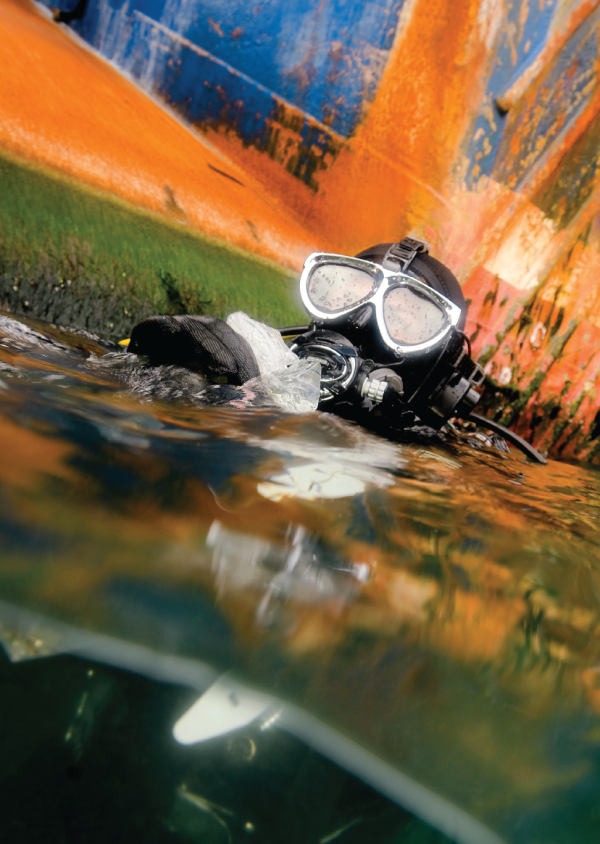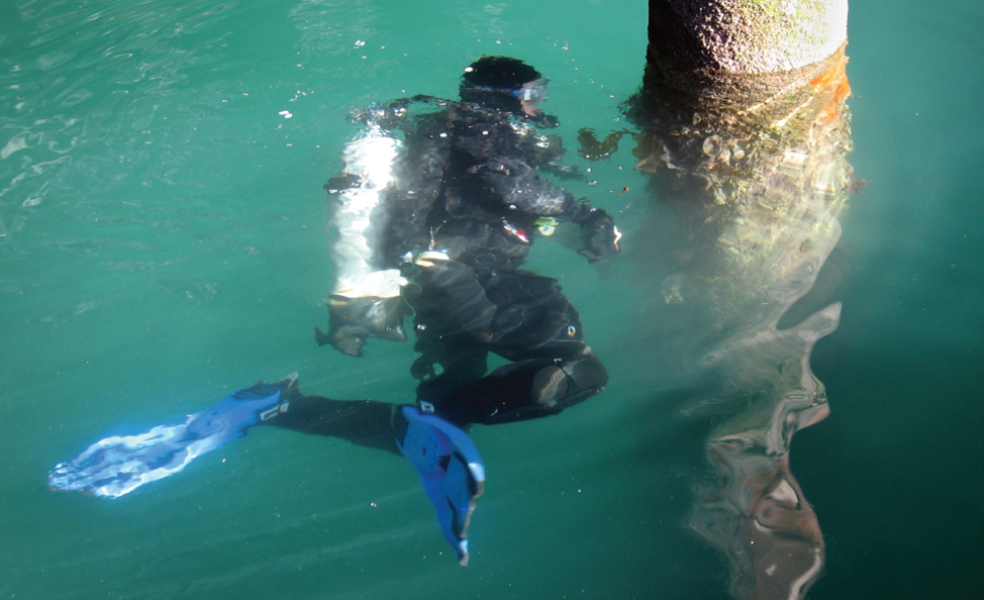The price of prosperous waters, finds Marieke Hilhorst, is eternal vigilance...New Zealand has at least 3.3 billion reasons to make sure our seas are free from invasive species.
According to a Statistics New Zealand report, in 2002 the marine economy contributed $3.3 billion to our gross domestic product. New Zealand's unique
Freeloaders aplenty
That presents a huge challenge. Every year, more than 45,000 cargo ships move up to 10.9 billion tonnes of ballast water globally, transporting an estimated 5000 or more species on any given day.
As a small, isolated island nation, international shipping carries our economy: 99.6 per cent of New Zealand's exports and 99.5 per cent of our imports travel by sea.
Each vessel, each trip, offers a lift to exotic hitchhikers, and the opportunities are growing: since 1960, annual international shipping arrivals have more than doubled from about 1000, to 2154 commercial vessels and 700 yachts and private vessels.
New overseas markets compound that risk, while cruise ships and yachts follow their own pathways, potentially harbouring still other pests.
An age-old problem
Invasive species are nothing new. Biofouling in New Zealand goes back to 1769, when Cook ordered his crew to scrub the Endeavour's hull not once, but twice, so snarled was it with barnacles and seaweed. By 2010, more than 300 exotic species had been recorded from New Zealand waters. Around half of them settled permanently.
Our focus on marine biosecurity has sharpened over time, and the rate of discovery has quickened. It took 188 years to record the first 114 species, but the next 35 were discovered in the space of just nine years.
NIWA Biosecurity Science Leader, Dr Graeme Inglis, says the detection rate has been particularly high over the past decade, thanks to national survey programmes funded by MAF Biosecurity New Zealand and implemented by NIWA and others. These include baseline surveys of marine species in New Zealand ports, ongoing targeted surveillance for high-risk marine pests, and a survey of biofouling on 500 international vessels to identify precisely where risks lie.
Another tool, the web-based Marine Biosecurity Porthole, launched last year, provides public access to MAF and NIWA data on marine invaders.
Marine Biosecurity Porthole website
Why worry?
The impacts of marine interlopers vary. Some are competitive, displacing native plants and animals. Others can alter the underwater seascape and change the way the ecosystems function. Some are so prolific that they can block shallow coastal waterways.
Humans are not immune: a major cholera epidemic in Peru in 1991 that killed 10,000 people was blamed on ballast water carrying an Asian strain of the disease.
In New Zealand, effects on human health have so far been mild, but we've nonetheless suffered environmental and economic costs. In 1967, a tubeworm, Ficopomatus enigmaticus, invaded the Whangarei tidal basin, forming encrustations 20cm thick on hulls and wharf piles. It then spread to Auckland's Tamaki estuary where, in 1980, it blocked the cooling-water intake of Otahuhu power station, forcing temporary closures.
In 2000, Gymnodinium catenatum, a microalgae of uncertain origin, bloomed in Manukau Harbour, where it caused the largest toxic algal bloom New Zealand had yet experienced. Shellfish gathering and mussel farming were closed along 1500km of coastline for nine months.
But marine invaders aren't always bad news. The Pacific oyster, Crassostrea gigas, which established here in the early 1970s, grows faster than the New Zealand rock oyster, and now drives a $30 million-a-year industry.
International leaders
The Ministry of Agriculture and Forestry (MAF) is responsible for the integrity of New Zealand's biosecurity systems – both terrestrial and marine – but works with other agencies to implement them, including NIWA and regional councils.
Dr Naomi Parker, MAF's Manager, Science and Policy, says New Zealand's isolation, economy and environment are strong motivations to take a lead on marine biosecurity.
Until recently, the major international focus has been on ballast water, and New Zealand is in the process of signing up to the International Maritime Organisation's (IMO's) Ballast Water Convention.
More information on the Ballast Water Convention
An Import Health Standard on ballast water discharges, already in place, will fulfil New Zealand's obligations under the IMO convention.
More recently, says Parker, biofouling has taken more emphasis, with research showing it's likely responsible for 87 per cent of arrivals in New Zealand waters. Parker says that sort of evidence drove a push with Australia, the United Kingdom and others to get biofouling on the international agenda, alongside ballast water. It worked: in July 2011, the IMO adopted voluntary international biofouling guidelines.
On the local stage
MAF is developing an Import Health Standard to manage biofouling. The new standard, due out in April 2012, doesn't target specific species. Rather, it aims to manage pathways, and reduce risk by providing an incentive for all vessel hulls to be as clean as possible before they arrive in New Zealand ports.
More information on Import Health Standards
The standard won't be enforced for another four years, says Paul Hallett, MAF's Team Manager, Operational Standards, so as "to give industry groups time to come up to speed, while encouraging early adoption. How each industry group meets the standard will depend on it and MAF working together to develop something that fits."
Last year, NIWA scientist Dr Oli Floerl, in collaboration with Australian scientist Ashley Coutts of Aquenel, revised the 1997 Australia New Zealand Environment Conservation Council (ANZECC) Code of Practice for Antifouling and In-Water Hull Cleaning and Maintenance for MAF and Australia's Department of Agriculture, Fisheries and Forestry (DAFF). Hallett says the guidelines – developed to manage toxic antifouling paint and cleaning chemicals – didn't sufficiently cover biosecurity risks, and needed to be brought up to date in other areas as well.
More information on the Code of Practice for Antifouling and In-Water Hull Cleaning and Maintenance
The revised Code includes mechanisms and information to help industry meet the new biofouling import standard.
NIWA's research has been integral to understanding what risks need to be covered by the new biofouling import health standard. In 2004, along with other researchers, NIWA began a two-year study that measured the biomass and identity of fouling organisms on the hulls of more than 500 vessels – merchant, fishing, recreational and passenger vessels, and towed barges. Within days of arrival, the vessels were surveyed and sampled to identify the species on their hull, their density and their location, and whether these were native or non-native. Vessel owners and operators were interviewed about where they had been, the hull's maintenance history and how much time had been spent in ports and at sea.
Floerl says the survey created what is possibly the world's most comprehensive dataset on vessel biofouling, travel history and maintenance. "The goal was to use statistical modelling to identify factors associated with a vessel's build, travel or maintenance history that will help determine the risk it poses to New Zealand's biosecurity."
Inglis says risk is a mix of things: "Our modelling showed that the most important contributors tended to be the time elapsed since the vessel was last painted with antifouling paint, whether it was fast or slow moving, and the amount of time it had been inactive in port. However, it also highlighted the complex mix of economic, geographic and ecological influences on biofouling that makes it difficult to accurately predict risk for individual vessels."
The data support MAF's marine biosecurity management decisions, including the development of a decision tree to identify the highest risk factors.
Parker says research by NIWA and others has helped ensure a rigorous, science-based Import Health Standard, and robust international biofouling guidelines. "Science is most definitely informing policy," she says.
The challenge of non-compliance
The next challenge is how best to deal with the suspected five per cent of vessels that MAF anticipates don't meet the standard. Turning vessels around at the border, or refusing them entry, is unlikely to find favour with New Zealand's trading partners.
As a first step, NIWA was contracted by MAF to provide an analysis of existing risk management options, such as dry docks, in-water cleaning or other biofouling management tools.
Floerl says the review found challenges with most existing options. For example, New Zealand has just two dry docks, which can only accommodate vessels shorter than 180m. What's more, the time and cost of dry docking make it a difficult option if either are in short supply.
Similarly, in-water cleaning has to be managed carefully, so that dislodged organisms can't settle on the seafloor. "We don't want to end up helping them to arrive," says Floerl. Most current cleaning practices weren't developed with biosecurity in mind. "The tools are good at cleaning the main hull surfaces of vessels to help with fuel efficiency, but most of them are large brush- or water jet-based systems that can't necessarily reach into the nooks and crannies where biofouling is often most diverse."
Surveillance
Managing risk pathways to stop marine pests arriving is just one part of the marine biosecurity jigsaw. Surveillance is another. NIWA is a key player in a MAF port surveillance programme to identify and respond to new exotic marine species before they take hold.
Inglis says NIWA's surveillance and survey work is underpinned by specialist taxonomic expertise. MAF draws on that knowledge under a service contract, the Marine Invasives Taxonomic Service (MITS), in which NIWA identifies novel species. Since 2005, MITS has handled more than 49,000 samples and identified more than 1200 organisms, including more than 200 exotic species.
More information on the Marine Invasives Taxonomic Service
Since 2001, MAF has funded NIWA and other research providers to complete 43 baseline surveys of ports and marinas. In addition, NIWA does twice-yearly surveys of 11 commercial ports and associated harbours, searching for 'least wanted' exotic species. A priority list currently has five primary and four secondary target species, but that varies over time, as new high-risk species emerge and/or others become established here.
In 2008, the programme found the highly invasive Mediterranean fanworm, Sabella spallanzanii, in Lyttelton Port. NIWA provided scientific and technical support to a MAF eradication effort, using statistical analysis and GIS mapping to direct commercial divers. As a result, they removed more than 97 per cent of the creatures.
Although the fanworm was later found in Auckland as well, the control programme in Lyttelton is seen as a success: monitoring shows the population hasn't rebounded. Much of NIWA's marine biosecurity work has an end-user focus, says Inglis. Largely funded by the Government, it's designed to provide benefits for New Zealand's economic prosperity and environmental stewardship. "I think it's fair to say that, with Australia, New Zealand is recognised internationally as being at the forefront of marine biosecurity research, because what we do is innovative and produces practical outcomes."



